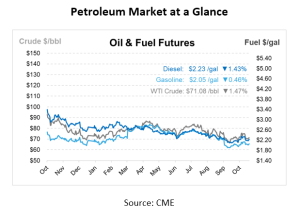
What’s That: SPCC
In the fuel industry, one of the most serious problems a business can face is an oil spill, which can have devastating effects on the environment and cause negative press for the company. It is important for drilling and fracking companies to comply with safety regulations and standards that help prevent such incidents. One of the most effective ways companies can manage environmental risks is by implementing a Spill Prevention, Control, and Countermeasure (SPCC) plan. In today’s What’s That Wednesday, we will explore how the SPCC rule helps companies develop, maintain, and integrate an oil spill prevention plan, fostering a responsible approach to oil handling. SPCC plans enable facilities to control oil and fuel spills if they occur, proactively mitigate environmental damage, and, ultimately, prevent spills.
What is the SPCC Rule
The Spill Prevention, Control, and Countermeasure (SPCC) rule is a regulation under the U.S. Environmental Protection Agency (EPA). It sets requirements to help prevent oil discharges from reaching waters and shorelines. The SPCC rule mandates that certain facilities storing large quantities of oil must prepare and implement an SPCC plan. This plan outlines how a facility will prevent oil spills, the measures in place to contain and clean up oil spills, and the countermeasures necessary to prevent oil discharge into the environment. The EPA includes a sample SPCC plan for an imaginary Midwest marina on its website. The SPCC rule requires the facility’s owner or operator to implement the plan, which must be maintained on-site at a facility that is attended for at least 4 hours each day.
An SPCC plan applies to facilities with an aggregate above-ground oil storage capacity of more than 1,320 gallons or a completely buried storage capacity of more than 42,000 gallons that could potentially discharge oil into U.S. water sources. Therefore, the geographic location of a facility is important – if a facility is far enough from any water sources, an SPCC plan may not apply. However, ditches, gullies, and storm sewers can still be considered potential pathways for oil discharge. The key components of an SPCC plan include prevention, control, and countermeasures. To prevent oil spills, facilities must implement practices such as proper storage, regular inspections, and employee training. In the event of a spill, facilities need containment systems, like berms or dikes, to control the oil release. A berm is a raised land area used to redirect fluids and prevent overflow, while a dike is a clay-built or stone structure made to hold back water. Finally, facilities must have emergency response plans in place to efficiently clean up spills and minimize environmental damage.
Why Do SPCC Plans Matter?
Oil spills can have devastating effects on the environment, including contaminating water supplies, destroying wildlife habitats, and causing long-term damage to ecosystems. The financial and reputational costs of oil spills can also be immense, potentially bankrupting companies and damaging consumer confidence.
SPCC plans act as a front line of defense, ensuring that oil and gas companies have the infrastructure, protocols, and training needed to prevent spills from occurring. The overarching objective is simple – to protect navigable waters and shorelines from oil contamination. However, the impact of an SPCC plan goes beyond environmental compliance – it demonstrates to consumers and stakeholders that a company prioritizes safety and environmental stewardship and actively takes measures to protect their communities.
How SPCC Plans Build Confidence Through Environmental Responsibility
For many consumers, environmental stewardship is an important factor when deciding which companies to support. When an oil and gas company implements a comprehensive SPCC plan, it is not only complying with federal regulations but also reinforcing its commitment to being a conscientious citizen. This responsible approach can serve as a competitive advantage, as most consumers prefer businesses that prioritize sustainability and environmental responsibility.
A well-executed SPCC plan shows that a company is not merely meeting regulatory requirements, but is actively striving to exceed them, positioning itself as a responsible corporate citizen. By integrating an SPCC plan, companies maintain consumer confidence through their demonstrated commitment to environmental protection, operational integrity, and proactive spill prevention measures. Additionally, these plans promote preparedness and response strategies, ensuring that facilities are equipped to mitigate the environmental and financial risks of oil spills, while contributing to long-term sustainability goals.
Select Environmental, a Mansfield Service Partners Company, has an expertly trained staff of experienced environmental managers who are ready to handle your waste streams safely and reliably. Our experts operate in compliance with government regulations, including TCEQ regulations 40 CFR 261.6 (4)], EPA used oil management standards (40CFR part 279), SPCC and OPA 90 oil spill contingency plans. Contact our team today and let us show you how to design a best practices approach to your environmental waste streams and SPCC compliance.


